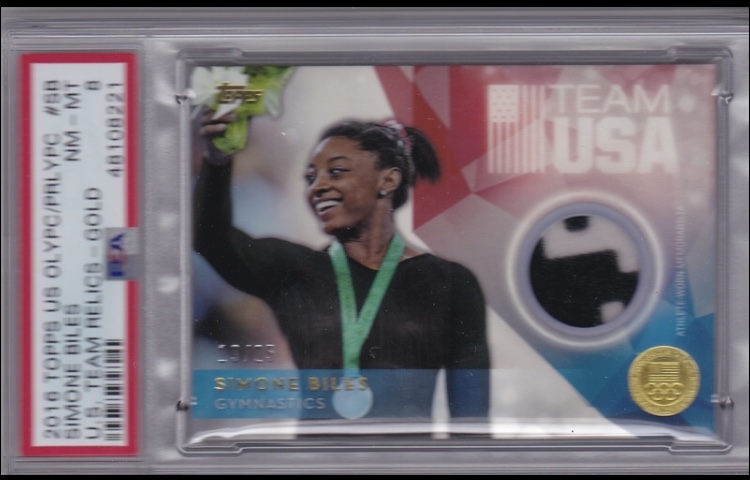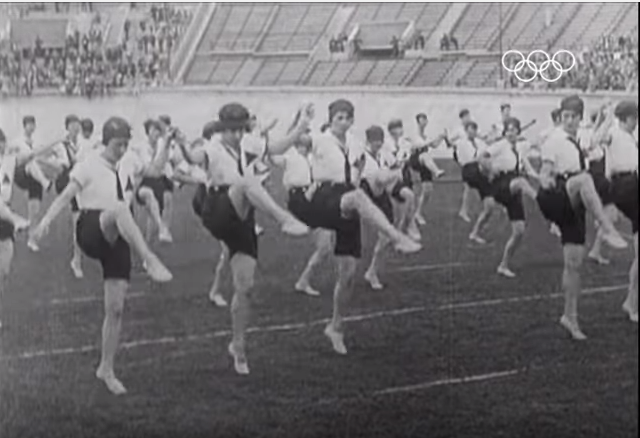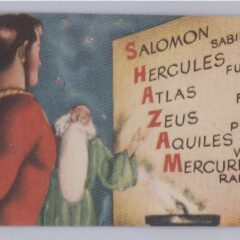The 2016 Olympics in Rio Janeiro, Brazil truly set the bar as our Nation led all nations for the fifth time over the past six Olympic Games. The total in the end would be a remarkable 121 medals, with 46 being Gold. Team USA Women contributed 61 of those 121 medals, 13 coming from our Final Five champions, the Women’s Gymnastics Team. If you were to close this chapter on the Team and the Sport of Gymnastics and simply say great work, you would truly miss out on the back story that makes this accomplishment so significant.
In order to truly appreciate this great achievement you have to go back to the beginning of the Women’s Gymnastics games as things were much different from the competitive venue we know today. From its inception at the 1928 Olympic Games which was won by the Netherlands in Amsterdam it would evolve thru the dominant Soviet Union years of 1952 up thru the 1980’s.
The Netherlands win stirring Gymnastics Gold – Amsterdam 1928 Olympics
The IX modern Olympics, held in Amsterdam in the summer of 1928, was the first Olympics held within the standard 16-day schedule; and, while it was not the first Olympics where women were allowed to compete (that was Paris in 1900), it was the first time women were allowed to compete in athletics and gymnastics. Many think it was due to the absence of the International Olympic Committee’s founder and second president, Pierre de Frédy, Baron de Coubertin, who is largely credited with beginning what is known as the modern Olympic movement. Coubertin was adamantly against women participating in sports, so it’s no coincidence that women were only allowed to compete in athletics and gymnastics after his departure in 1925, and that the number of women competing in the 1928 Olympics more than doubled the number competing at the Paris Games in 1924. The format of the gymnastics competition, however, was very different from what we see today. While the men had nearly the same number of events: a team final, an all-around final, and an individual final for every apparatus except floor, the women only competed in a team final. There were 60 women in total competing, and they formed five teams of twelve each. Ten of the twelve gymnasts on each team competed in three events, known as Drill, Apparatuses, and Jumps, and scores on each were combined for a total team score. By Contrast the 2016 USA Women’s team consisted of 5 players and the venues now included: Women’s Individual All-Around, Women’s Team All-Around, Women’s Vault, Women’s Balance Beam, Women’s Uneven Bars & Women’s Floor Exercises.
It is unclear what was actually involved in these events but early videos show women doing synchronized exercises in the Olympic stadium in what now looks like a group stretching session. Early videos from the 1936 Olympics showed women participating on vault, uneven bars, beam, and parallel bars, though it is unclear if these were the same events used in 1928.
The United States 1st Women’s Olympic Gymnastic Champions – Team USA’s Forgotten Pioneers
The 1948 London games were a significant period in the Olympic Games as the 1940 & 1944 games had been suspended and the last games played were in 1936 due to the War. Given World War II had taken a great toll in lives and resources, England and other countries considered reinvigorating the Olympics again in the hope that it might help restore the ideas of peace and unity around the Globe. While the idea was a noble one, there was still many grim reminders of the recent war and political tensions that were impacting the 1948 Games.
Germany, the reigning Olympic gold medalist in women’s gymnastics up to this point and Japan were not invited to compete as they were under Allied military occupation, and while the USSR was invited to the Games, they chose not to participate. The war, and the cancellation of the 1940 and 1944 Olympics, meant, for many gymnasts, that their Olympic dreams would never come to pass. One such gymnast was Pearl Perkins, a Jewish athlete who won the national all-around title in 1937, 1941, and 1943. Perkins was named to the 1936 United States Olympic team, but her parents did not allow her to attend due to Berlin’s anti-semitic environment. Perkins would continue to train through 1940 and 1944, but her opportunity to participate in the Olympics never arrived.
Helm McKee, the 1938 and 1944 U.S. national champion, was forbidden from attending the Olympics due to political tensions between her coach and the Amateur Athletics Union. She set her sights on the 1940 and 1944 Olympics, but was never able to compete. Margaret Weissman, the 1939 national champion, would also miss the opportunity to go to the Olympics, along with Roberta Ranck, the first-ever national champion, whose knee injury prevented her from attending in 1936.
Despite the absence of some of its early champions, the United States’ Olympic team would be boosted by the efforts of more recent national champions and gymnasts who had waited patiently for their shot at the Games. The 1945 and 1946 national champion and Olympic team captain Clara Schroth and 1947 and 1948 national champion Helen Shifano, were joined by the 1936 Olympian Consetta Lenz, who had two children between her Olympics and had only trained for six months before tryouts. Bakanic, Meta Elste (a former circus performer), Marian Barone, Dorothy Dalton, and Anita Simonis rounded out the team. The United States Olympic Team tryouts took place at Temple University on April 9, four months before the Olympic competition, and the top eight all-around gymnasts were chosen for the team.
This would be the first time the United States had competed internationally in women’s gymnastics since the 1936 Olympic Games, as no team was sent to the 1938 World Championships. When the Women’s Gymnastics team arrived for the 1948 London Olympics Games they met with the largest international competition that had ever been held for women’s gymnastics. Eleven teams participated, up from eight in 1936 and five in 1928, and eight women competed on each team. Similar to previous Olympics, women would only be allowed to compete in a team final, and they would be given a team score based on group exercises (one with and one without portable apparatuses) and individual apparatuses. However, in this Olympics, women did not compete on bars, but instead competed on the rings. Each team member did a compulsory exercise on rings, along with compulsory and voluntary exercises on beam and vault.
In spite of all the challenges faced by this incredible group of talented women, they would end up winning the Bronze Medal the first Olympic Women’s Gymnastic medal for the USA. Unfortunately this would be the first and last medal won by the USA until 1984 due to the incredible talent and dominance of the Soviet Union and other nations such as: Hungary, Czechoslovakia, Romania, Japan and East Germany.
The Female Athletes that emerged from the 1950’s thru the 80’s were a relative Who’s Who of Gymnastic talent that we would come to regard as Legends in the Sport today. Of all these early Gymnasts, the one most remembered then and know is Former Soviet artistic gymnast Larisa Semyonovna Latynina. Latynina was born on December 27, 1934, and has won 14 Olympic medals in individual events and four medals in team events between 1956 and 1964. Her amazing achievement of 18 Olympic medals stood unbeaten for 48 years until that faithful day on July 13th 2012, when Olympic Swimmer Michael Phelps beat that record to become the most decorated Olympian of all time. Latynina still holds the record for most medals in an individual event. She won five out of six titles in World Championships in 1958 despite being four months pregnant at that time. Latynina is the only woman to win an all-around medal in more than two Olympic Games and also the only female athlete to win an individual event in more than two Olympic Games. This legendary female gymnast was inducted into the International Gymnastics Hall of Fame in 1998. There were other greats though during this incredible 48 year span by the Soviets that included: Agnes Keleti, Polina Astakhova, Ludmilla Tourischeva, Olga Korbut, Nellie Kim & Yelena Davydova. This Dynasty of greatness would eventually die out with the last great stars of the 1980’s that of Yelena Shushunova, Svetlana Boginskaya, and Svetlana Khorkina.
Woman’s Olympic Gymnastics –The 1950’s in Contrast to Today.
By the 1970’s other countries were emerging on the scene with new talents of their own. Romania would be one of the most memorable of these nations. They would pit a young 14 year old name Nadia Comaneci against their great champions and find that in her they had found Perfection. Little would the world realize that the face of Gymnastics would be changed on that faithful day on July 18th 1976 in Montreal, Canada were she recorded her first of seven perfect “10” scores. She would remind the world that the test of a true champion comes from discipline, sacrifice, hope and faith in one’s own ability to push past the pain and fears and reach for the stars. She was a star that day one of many that would grace the Olympic stage. Other Romanian Gymnast would follow in her path, like Daniela Szabo, Daniela Silivas, Lavinia Milosovici, and Simona Amanar. They would make their own mark on the Olympic Podium as well.
Nadia Comaneci’s accomplishments went beyond the medals and perfect scores. Others would remember her for her ability to inspire others to be great. It’s during the peak of Romania’s dominance that a small American gymnast received her own inspiration while watching Nadia Comăneci outshine defending Olympic champion Olga Korbut on television at the 1976 Summer Olympics in Montreal. Her name the world would come to know was Mary Lou Retton. She took up gymnastics in her hometown of Fairmont and would then decide to move to Houston, Texas, to train under Romanians Béla and Márta Károlyi, who had coached Nadia Comăneci before their defection to the United States.
Under the Károlyis, Retton soon began to make a name for herself in the U.S., winning the American Cup in 1983 and placing second to Dianne Durham (another Károlyi student) at the US Nationals that same year. Retton missed the World Championships in 1983 due to a wrist injury. Nevertheless, Retton won the American Classic in 1983 and 1984, as well as Japan’s Chunichi Cup in 1983. After winning her second American Cup, the U.S. Nationals, and the U.S. Olympic Trials in 1984, Retton would overcome a knee injury that would require her to undergo an operation five weeks prior to the 1984 Summer Olympics. She recovered just in time for the Olympics in Los Angeles, California. In the competition, which was boycotted by the Soviet bloc nations except for Romania, Retton was engaged in a close battle with Ecaterina Szabo of Romania for the all-around gold medal. Trailing Szabo (after uneven bars and balance beam) by 0.15 with two events to go, Retton scored perfect 10s on floor exercise and vault — the last event in an especially dramatic fashion, as there had been fears that her knee injury and the subsequent surgery might impair her performance. Retton won the all-around gold medal by 0.05 points, beating Szabo and becoming the first American to receive the all-around gold medal. She also became the first female gymnast from outside Eastern Europe to win the individual all-around gold.
Magnificent Seven’ Gymnastics Team Recalls Olympic Glory
While it would take 3 Olympics after Retton’s great accomplishment for America to return back to the Olympic Medal World Stage the battle cry of USA was once again shouted from the roof tops in 1996 at the Olympic Games in Atlanta. It was there that a small band of Gymnastic Warriors would take the stage and pick up where Retton had left off. Here the United States Olympic women’s gymnastics team appropriately titled the Magnificent Seven would win the first ever gold medal for the United States in the women’s team competition.
The seven members of this great new Dynasty were Shannon Miller, Dominique Moceanu, Dominique Dawes, Kerri Strug, Amy Chow, Amanda Borden, and Jaycie Phelps. It should be noted that Miller, Dawes, and Chow also won individual medals as well in the 1996 Olympics. Along with these great accomplishments, was one particular memory in which Keri Strug stuck the landing on a vault while injured. Having under rotated her landing after her first attempt, she ended up falling and damaging her ankle. The attempt had however received a judge’s score of 9.162 points. This would not be however enough to secure gold so Strug would have to attempt a second vault while injured and land on her feet in order to secure the Gold for the Team USA.
With everything on the line, between vaults, she went to Bela Korolyi and asked and “Do we need this to win?” Korolyi responded with confidence and an assurance that overcame the pain for Kerri, “we need you one more time for the Gold”. You can do it, you better do it”. Kerri limped to the end of the runaway as the world watched in anticipation, and landed with both feet and then instantly hopped onto her one good foot and saluted back to the judges and then collapsed onto her knees requiring assistance to leave the landing platform. Even though she was in excruciating pain, she would look up to see her score of 9.712, a score that would clinch Gold for Team USA in the Team All-Around.
The team’s gold medal victory was considered phenomenal for the United States considering the former Soviet Union had won this event in every Olympics going back to the 1950s. Furthermore, the United States had never won the event in either the Olympics or the World Championships, yet in Atlanta, they fielded the deepest American team in history up to that point and upstaged both the Russians and the Romanians, then reigning World Champions.
Retton is credited with being a pioneering figure in American women’s gymnastics, her hard work and dedication helped inspire others to take the Olympic baton and follow in her footsteps with the same drive and tenacity. Along with the Magnificent Seven, there was also Carly Patterson (Athens in 2004), Nastia Liukin (2008 in Beijing), Gabby Douglas (2012 in London), and Simone Biles (2016 in Rio de Janeiro). Twice during that span, Americans also took silver as part of a one-two finish: Shawn Johnson in 2008 and Aly Raisman in 2016. Furthermore, prior to Retton’s Olympic triumph, no American woman had won all-around gold at the World Championships; since then, seven Americans have done so a combined ten times – in chronological order, Kim Zmeskal, Shannon Miller (twice), Chellsie Memmel, Shawn Johnson, Bridget Sloan, Jordyn Wieber and Biles (three times).
The Fierce Five Great Moments In Team USA History
Each of their achievements helped to inspire a new group of future hopefuls leading to the 2012 power house team that would take the bar even higher for the USA Women’s Gymnastics – the Fierce Five. Starting in 2012 in London, Team USA (composed of: Gabrielle Douglas, Jordyn Wieber, Aly Raisman, Kyla Ross and McKayla Maroney) would first win the coveted Gold Medal in the Team All- Round Competition, a feat that had not been accomplished since the Magnificent Seven had first accomplished it in 1996. This would be followed by Gabby Douglas’s Gold medal win in the Individual All-Around competition.
Team USA was not finished yet, as members from the original Fierce Five squad in 2012 would come back with new talent composed of: returning Team Captain Aly Raisman & Individual All-Around God Medal Winner from 2012 Gabby Douglas along with 2015 world champion in the Uneven Bars Madison Kocian, three-time world all-around champion* (2013–15) Simone Bile and new comer and secret weapon Laurie Hernandez. Hernandez competed at the Pacific Rim Gymnastics Championships in Everett, Washington, along with Raisman, and Simone Biles, and contributed an all-around score of 59.800 toward the American team’s first-place finish.
* Note: Russian gymnast Svetlana Khorkina holds the record for the most World Championships medals (20), while American Simone Biles has won the most gold medals (10) in World Championship history.
Together they would lead the U.S. Women’s Gymnastic Team by four points midway through the 2016 Rio competition and outdistance second-place Russia by 8.209 points, the equivalent to several touchdowns in a football game. Team USA ended the day with 184.897 points, Russia with 176.688 and China 176.003. The only thing left to do at this point was to take the mike and let it drop to the floor as there was nothing left to say, their skill, energy and power spoke volumes for them in the end. They would leave the Medal Podium with a total of 13 Olympic Medals and multiple accolades:
- 2016 Repeat Team All-Around Gold Medal Champions (1st USA Olympic Woman’s Gymnastic Team to ever win Gold in this event in 2 consecutive Olympic Games).
- 2016 USA squad repeats Individual All-Around Gold Medal Championship Win (increasing Team USA Woman’s Gymnastic Team consecutive win streak to 4 Olympic Gold Medals – 2004 Carly Patterson, 2008 Nastia Liukin, 2012 Gabby Douglas & 2016 Simone Biles).
- Simone Biles also has the distinction of winning four golds and one bronze during the 2016 Olympic Women’s Gymnastics Games, making her the most decorated U.S. gymnast ever in a single Olympics.
- 2016 Final Five Team also Holds a New Record for most Gold medals Events won by a USA Women’s Olympic squad in a single Olympics (4*). The previous record was 3 Gold medal event wins accomplished in 2012 when the squad was titled Fierce Five.
[*See Team USA’s Olympic Medal Breakdown below]
It’s fitting that they would take their Bow in 2016 and claim a new team moniker fitting for such greatness, “The Final Five”. They picked this for several reasons, one was that they would be the final Olympic team to be composed of 5 Athletes as 2020 the Games in Tokyo will be consist of only 4 athletes. The other reason is they are the final team to train under the watchful eye of national team coordinator Martha Karolyi. At age 73 Mrs. Karolyi looks back at her 40 years in the sport and realizes it’s time for her to retire. She couldn’t have gotten a better gift than Gold, it’s a fitting tribute to someone who has given so much to this sport and to every athlete she molded and prepared for greatness along with Bela Korolyi. The Names are a relative who’s who like Nadia Comaneci, Mary Lou Retton, Kim Zmeskal, Kerri Strug, Shannon Miller, Dominique Moceanu, Dominique Dawes, Amy Chow, Amanda Borden, Jaycie Phelps, Carly Patterson, Courtney Kupets, Shawn Johnson, Nastia Liukin, Alicia Saramone, McKayla Maroney, Kyla Ross, Jordyn Wieber and the Final Five.
When you look at their accomplishments in light of the back drop story of other greats that have helped pave the way you see true greatness. A greatness that is built not just on talent but in humility, sacrifice and devotion to their craft and each other. They also realize that their support group is a large one, it consist of their coaches, families, communities, and finally their fans. As fans we also feel their pain when they fall and the sense of hope when they get backup and refuse to quit. Their determination and commitment to their dreams fuels our own. Each of these stars reminds us that we are capable of achieving Gold in our own lives as we learn to trust in God and support each other. This is what makes this country so great.
You can bet I’ll be watching the Tokyo Games come 2020 both as a fan and Collector of this great Sport! Our next article will focus on some of the great cards that exist today for you the adventurous collector on each of these great stars.
Until then don’t forget today’s cardboard could be Tomorrow’s Gems!
All-Around, Individual
| Games | Gold | Silver | Bronze |
| 2016 Rio de Janeiro | Simone Biles United States |
Aly Raisman United States |
Aliya Mustafina Russia |
All-Around, Team
| Games | Gold | Silver | Bronze |
| 2016 Rio de Janeiro | United States (USA) Aly Raisman Madison Kocian Gabrielle Douglas Simone Biles Laurie Hernandez |
Russia (RUS) Aliya Mustafina Angelina Melnikova Maria Paseka Daria Spiridonova Seda Tutkhalyan |
China (CHN) Fan Yilin Mao Yi Shang Chunsong Tan Jiaxin Wang Yan |
Balance beam
| Games | Gold | Silver | Bronze |
| 2016 Rio de Janeiro | Sanne Wevers Netherlands |
Laurie Hernandez United States |
Simone Biles United States |
Floor exercise
| Games | Gold | Silver | Bronze |
| 2016 Rio de Janeiro | Simone Biles United States |
Aly Raisman United States |
Amy Tinkler Great Britain |
Uneven bars
| Games | Gold | Silver | Bronze |
| 2016 Rio de Janeiro | Aliya Mustafina Russia |
Madison Kocian United States |
Sophie Scheder Germany |
Vault
| Games | Gold | Silver | Bronze |
| 2016 Rio de Janeiro | Simone Biles United States |
Maria Paseka Russia |
Giulia Steingruber Switzerland |
| Year | Location | Gold | Silver | Bronze |
| 2013 | Antwerp | Simone Biles | Kyla Ross | Aliya Mustafina |
| 2014 | Nanning | Simone Biles | Larisa Iordache | Kyla Ross |
| 2015 | Glasgow | Simone Biles | Gabby Douglas | Larisa Iordache |
 Copyright protected by Digiprove © 2016
Copyright protected by Digiprove © 2016



















Leave a Reply